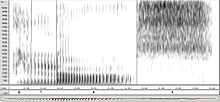Segment (linguistics)

In linguistics, a segment is "any discrete unit that can be identified, either physically or auditorily, in the stream of speech".[1] The term is most used in phonetics and phonology to refer to the smallest elements in a language, and this usage can be synonymous with the term phone.
In
Segments are called "discrete" because they are, at least at some analytical level, separate and individual, and temporally ordered. Segments are generally not completely discrete in speech production or perception, however. The articulatory, visual and acoustic cues that encode them often overlap. Examples of overlap for spoken languages can be found in discussions of phonological assimilation, coarticulation, and other areas in the study of phonetics and phonology, especially autosegmental phonology.
Other articulatory, visual or acoustic cues, such as prosody (tone, stress), and secondary articulations such as nasalization, may overlap multiple segments and cannot be discretely ordered with them. These elements are known as suprasegmentals.
Types
In phonetics, the smallest perceptible segment is a phone. In phonology, there is a subfield of segmental phonology that deals with the analysis of speech into phonemes (or segmental phonemes), which correspond fairly well to phonetic segments of the analysed speech.
The segmental phonemes of
Marginal segments
When analyzing the inventory of segmental units in any given
Suprasegmentals
Some contrastive elements of speech cannot be easily analyzed as distinct segments but rather belong to a syllable or word. These elements are called suprasegmental, and include intonation and stress. In some languages nasality and vowel harmony are considered suprasegmental or prosodic by some phonologists.[3][4]
See also
References
Citations
- ^ Crystal 2003, pp. 408–409.
- ^ Bussmann 2006, p. 1038.
- ISBN 978-0-19-437036-3.
- .
Sources
- Crystal, David (2003), A Dictionary of Linguistics & Phonetics, Blackwell
- Gussenhoven, Carlos; Jacobs, Haike (2005) [1998], Understanding Phonology (2nd ed.), Hodder & Arnold
- Bussmann, Hadumod (2006), Routledge Dictionary of Language and Linguistics, Routledge, ISBN 978-1-134-63038-7
